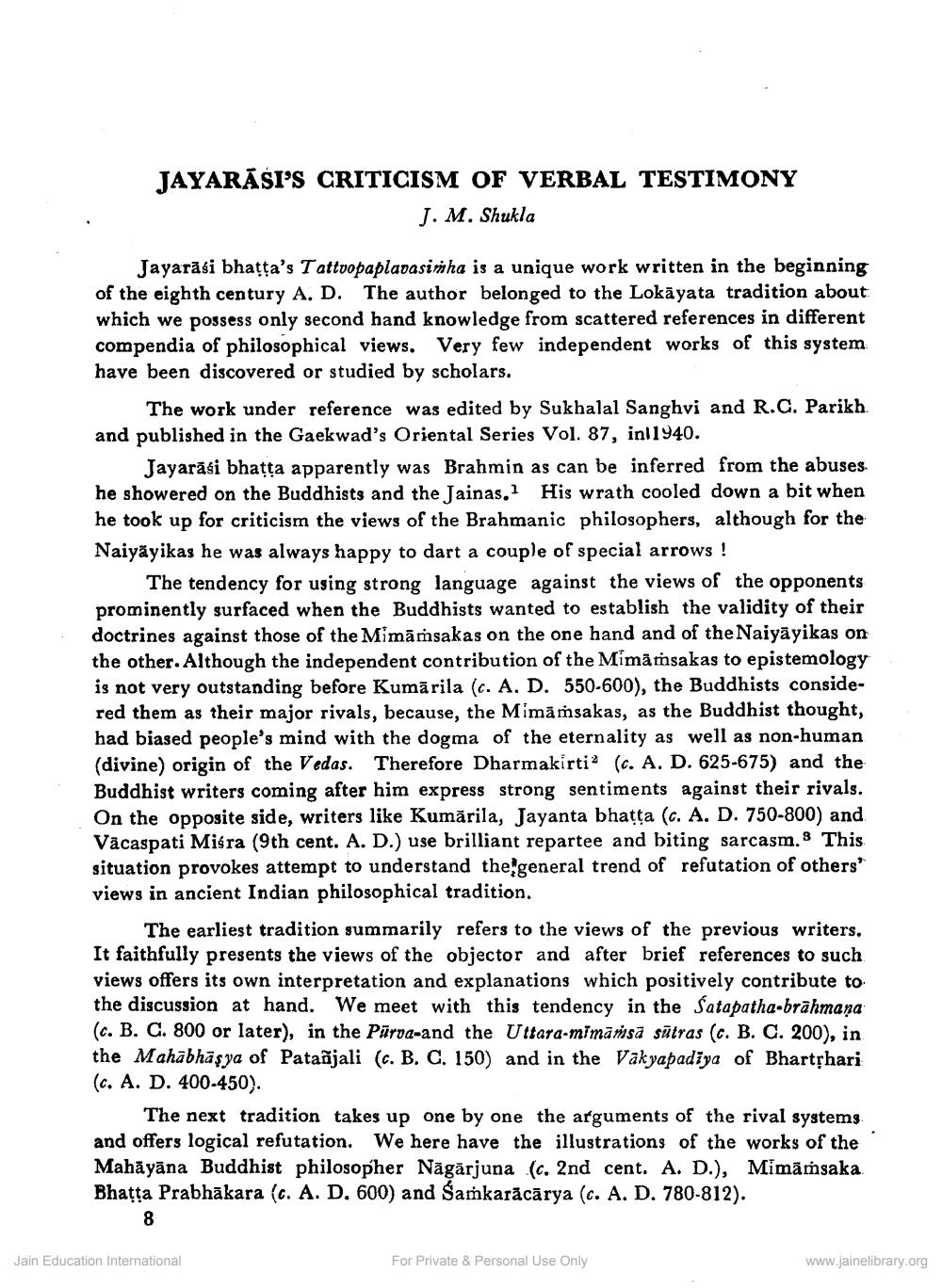Book Title: Jayarasi Criticism of Verbal Testimony Author(s): Jaydev M Shukla Publisher: Z_Aspect_of_Jainology_Part_2_Pundit_Bechardas_Doshi_012016.pdf View full book textPage 1
________________ JAYARĀSI'S CRITICISM OF VERBAL TESTIMONY J. M. Shukla Jayarāsi bhatta's Tattvopaplavasimha is a unique work written in the beginning of the eighth century A. D. The author belonged to the Lokāyata tradition about which we possess only second hand knowledge from scattered references in different compendia of philosophical views. Very few independent works of this system have been discovered or studied by scholars. The work under reference was edited by Sukhalal Sanghvi and R.C. Parikh and published in the Gaekwad's Oriental Series Vol. 87, in 1940. Jayarăsi bhatta apparently was Brahmin as can be inferred from the abuses he showered on the Buddhists and the Jainas. His wrath cooled down a bit when he took up for criticism the views of the Brahmanic philosophers, although for the Naiyāyikas he was always happy to dart a couple of special arrows ! The tendency for using strong language against the views of the opponents prominently surfaced when the Buddhists wanted to establish the validity of their doctrines against those of the Mimāṁsakas on the one hand and of the Naiyāyikas on the other. Although the independent contribution of the Mimāṁsakas to epistemology is not very outstanding before Kumārila (c. A. D. 550-600), the Buddhists considered them as their major rivals, because, the Mimāṁsakas, as the Buddhist thought, had biased people's mind with the dogma of the eternality as well as non-human (divine) origin of the Vedas. Therefore Dharmakirtia (c. A. D. 625-675) and the Buddhist writers coming after him express strong sentiments against their rivals. On the opposite side, writers like Kumārila, Jayanta bhatta (c. A. D. 750-800) and Vacaspati Misra (9th cent. A. D.) use brilliant repartee and biting sarcasm. This situation provokes attempt to understand the general trend of refutation of others views in ancient Indian philosophical tradition. The earliest tradition summarily refers to the views of the previous writers. It faithfully presents the views of the objector and after brief references to such views offers its own interpretation and explanations which positively contribute to the discussion at hand. We meet with this tendency in the Satapatha-brahmana (c. B. C. 800 or later), in the Pürva-and the Uttara-mimāṁsā sūtras (c. B. C. 200), in the Mahābhāşya of Patañjali (c. B. C. 150) and in the Vakyapadiya of Bhartshari (c. A. D. 400-450). The next tradition takes up one by one the arguments of the rival systems and offers logical refutation. We here have the illustrations of the works of the Mahāyāna Buddhist philosopher Nāgārjuna (c. 2nd cent. A. D.), Mimämsaka Bhatta Prabhākara (c. A. D. 600) and Samkarācārya (c. A. D. 780-812). Jain Education International For Private & Personal Use Only www.jainelibrary.orgPage Navigation
1 2 3 4 5 6 7 8 9 10 11 12 13
